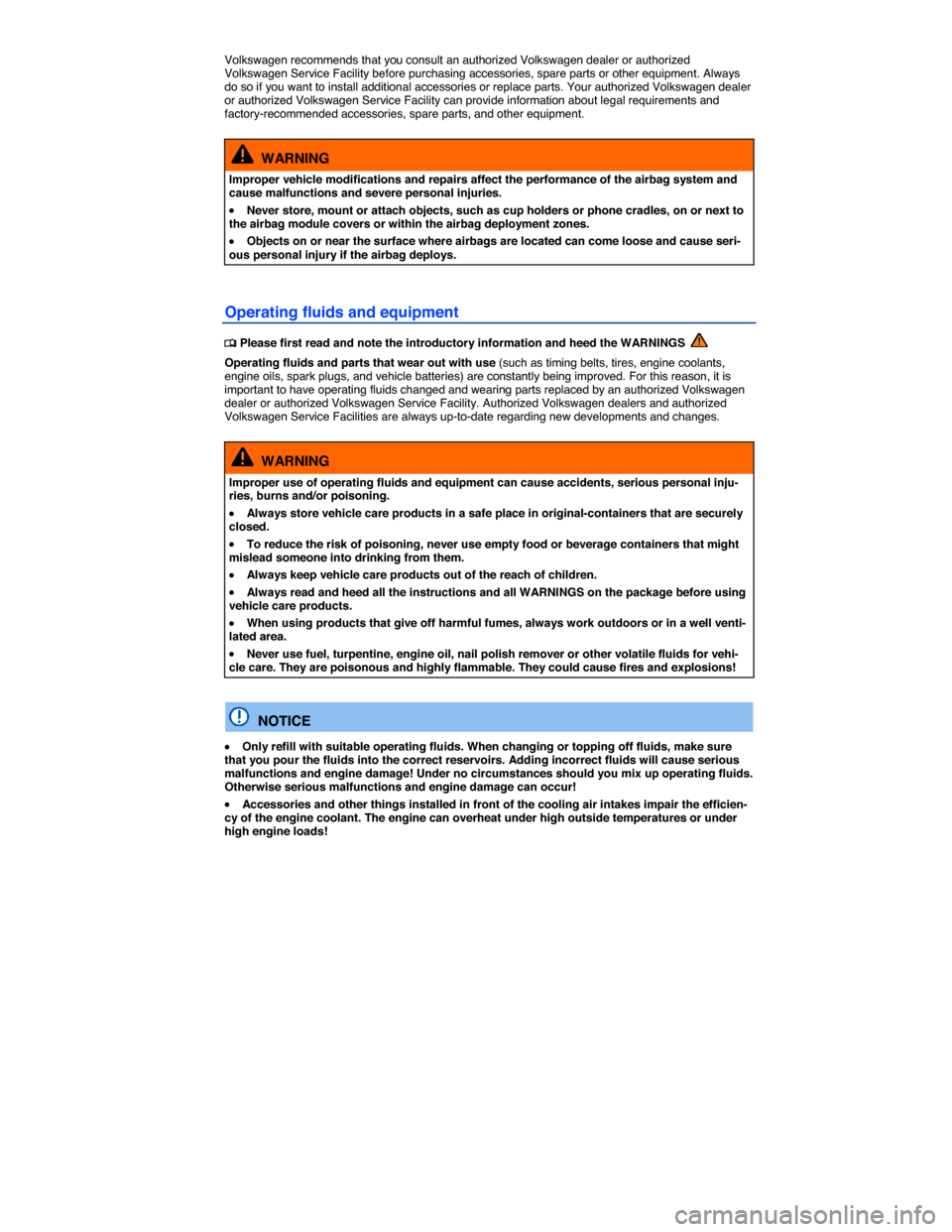2015 VOLKSWAGEN PASSAT deployment
[x] Cancel search: deploymentPage 33 of 397

Safe & Secure:
Feature Description
Automatic Crash Notification (ACN)
Automatic Crash Notification is initiated in the event of airbag deployment or rollover. When the feature is activated the Volkswagen Car-Net Response Center is notified of your location and contacts your vehicle to determine the risk of injury and to dispatch help. Help is dispatched even if the Volkswagen Car-Net Response Center does not connect to the vehicle's occupants. Auto-matic Crash Notification may be engaged for up to 6 months without activating a trial or paid subscription.
Manual Emergency Call
In the case of an emergency, press the • button in the 3-button module: The Volkswagen Car-Net device initiates a connection to the Volkswagen Car-Net Response Center. The location of the vehicle and customer data for identifica-tion is sent at the same time.
Roadside Assis-tance
Press the �> button in the 3-button module: The vehicle will connect directly to the Volkswagen Roadside Assistance Call Center. The vehicle’s location is also transmitted in order to more quickly provide assistance.
Stolen Vehicle Location Assis-tance For use by law enforcement au-thorities only. See Terms of Service at www.vw.com/carnet for details.
After you have reported your vehicle as stolen to law enforcement, you may provide the case information to the Volkswagen Car-Net Response Center. Once the information has been verified, the VW Car-Net Customer Specialist will be able to provide law enforcement with vehicle location data sent by the VW Car-Net module.
Family Guardian:
Feature Description
Boundary Alert
By logging on to your Volkswagen Car-Net account, you can designate an area on a map as a “virtual fence.” The vehicle owner can then choose notification channels (text message or email) for receiving alerts when the vehicle crosses the defined boundary (texts and data rates apply).
Speed Alert
Volkswagen Car-Net can be configured to inform the vehicle owner whenever the vehicle exceeds a speed set by the owner. The owner can select to be informed through multiple channels, including text messages and email (text and data rates apply).
Remote Vehicle Access:
Feature Description
Page 106 of 397

Accident statistics show that vehicle occupants properly wearing safety belts have a lower risk of being injured and a much better chance of surviving a collision. Properly using safety belts also greatly increases the ability of the supplemental airbags to do their job in a collision. For this reason, wearing a safety belt is required by law in most countries including the United States and Canada.
Although your Volkswagen is equipped with airbags, you still have to wear the safety belts provided. Front airbags, for example, are activated only in some frontal collisions. The front airbags are not activated in all frontal collisions, in side and rear collisions, in rollovers, or in cases when the condi-tions for deployment stored in the electronic control unit are not met. The same goes for the other airbag systems on your Volkswagen.
So always wear your safety belt and make sure that everybody in your vehicle is properly restrained!
Using safety belts
�
Page 144 of 397

WARNING
Unsecured or incorrectly stowed items can fly through the vehicle, causing serious personal injury during hard braking or sharp steering or in an accident. Loose items can also be struck and thrown through the passenger compartment by the front airbags if they inflate. To help reduce the risk of serious personal injury:
�x Always stow all objects securely in the vehicle. Always put luggage and heavy items in the luggage compartment.
�x Always secure objects in the passenger compartment properly with suitable straps so that they cannot move into the deployment zone of a side or front airbag during sudden braking, in a sudden maneuver, or in a collision.
�x Always keep storage compartments closed while driving.
�x Never stow hard, heavy, or sharp objects in the vehicle's open storage compartments, on the shelf behind the rear seat bench, or on the top of the instrument panel.
�x Always remove hard, heavy, or sharp objects from clothing and bags in the vehicle interi-or and stow them securely in the luggage compartment.
WARNING
Transporting heavy objects causes the handling characteristics of the vehicle to change and increases braking distances. Heavy loads which are not properly stowed or secured in the vehicle can lead to a loss of vehicle control and cause serious personal injury.
�x Transporting heavy items causes the handling characteristics of the vehicle to change by shifting the vehicle's center of gravity.
�x Always distribute luggage evenly and as low as possible within the vehicle. The vehicle capacity weight figures apply when the load is distributed evenly in the vehicle (passengers and luggage).
�x Always stow luggage and heavy items in the luggage compartment as far forward of the rear axle as possible and secure them with appropriate straps to the tie-downs provided.
�x Never exceed the vehicle's Gross Vehicle Weight Rating or Gross Axle Weight Ratings, which are printed on the Safety Compliance Certification Label located on the door jamb of the driver door. Exceeding the permissible weight can cause the vehicle to skid and behave differently.
�x Always adapt your speed and driving style to accommodate your payload and its weight distribution within your vehicle.
�x Be especially cautious and gentle when stepping on the accelerator pedal and avoid sud-den braking and other maneuvers.
�x Brake earlier than you would if you were not driving a loaded vehicle.
NOTICE
The defroster heating wires or antenna in the rear window can be damaged by objects that rub against them.
The ventilation slots between the rear window and the luggage compartment cover must not be blocked so that stale air can escape from the vehicle.
Page 204 of 397

WARNING
Clothes or other items on the shelf behind the rear seat backrest may limit visibility, and cause accidents and severe personal injuries.
�x Always hang clothes so that they do not limit visibility.
�x Always use the built-in coat hooks only for lightweight clothing. Never leave any heavy or sharp-edged items in the pockets that may interfere with airbag deployment and can cause personal injury in a collision.
Page 319 of 397

�x Unlock the vehicle before disconnecting the battery; otherwise the alarm system will go off.
�x First disconnect the negative cable (-) and then the positive cable (+) ⇒ .
Connecting the vehicle battery
�x Prior to reconnecting the battery, switch off all electrical systems and devices and the ignition.
�x Connect the positive cable (+) first and then the negative cable (-) ⇒ .
After the battery is connected and the ignition is switched on, different indicator lights may come on. They should go out after you drive a short distance at 10–12 mph (15–20 km/h). If the indicator lights do not go out , contact an authorized Volkswagen dealer or an authorized Volkswagen Service Facility and have the vehicle checked.
If the battery was disconnected for a long time, the next scheduled service may not be correctly calcu-
lated and displayed ⇒ Instrument cluster The maximum permissible service and maintenance inter-
vals are shown in the ⇒ Booklet Warranty and Maintenance.
Vehicles with Keyless Access
If the ignition will not start after reconnecting the vehicle battery, lock the vehicle from the outside and
unlock it again ⇒ Unlocking and locking vehicles with Keyless Access. Then try to start the ignition again. If the ignition cannot be switched on, contact an authorized Volkswagen dealer, an authorized Volkswagen Service Facility, or another qualified workshop for assistance.
Automatic electrical load deactivation
If the vehicle battery drain is high, the intelligent onboard electrical system management automatically takes steps to help prevent battery drain.
�x The idle speed is increased so that the alternator provides more power.
�x The power to devices that consume a lot of electricity is cut back or switched off completely.
�x When the engine is started, the power supply to the 12 Volt sockets and the cigarette lighter ⇒ Cigarette lighter is temporarily interrupted.
The onboard electrical system management cannot always keep the battery from being drained. For example, the battery will drain if the engine is not running, but the ignition is switched on or the parking lights are left on for a long time when parked.
Battery disconnection in an accident with airbag deployment
In vehicles with a battery in the luggage compartment, the electrical connection to the battery is dis-connected automatically in a collision with airbag deployment. This helps to prevent a short-circuit.
What drains the vehicle battery?
�x Long periods when the engine is not running, especially when the ignition is on.
�x Using electrical systems or devices when the engine is switched off.
�x Leaving the vehicle unlocked for several days when not in use.
�x The selector lever is left for a long period of time in any position other than P when the ignition is
switched off ⇒ Automatic transmission: Selector lever.
WARNING
Failure to use the proper battery with proper mounting and connections may cause short circuits, fires, and serious personal injuries.
�x Always use only maintenance-free or cycle-free, leak-proof batteries with the same speci-fications and dimensions as the original equipment battery. Specifications are listed on the battery housing.
Page 339 of 397

WARNING
Inappropriate spare parts and accessories as well as unprofessionally performed work, modi-fications and repairs can cause vehicle damage, accidents and serious personal injuries.
�x Volkswagen strongly recommends to only use accessories approved by Volkswagen and Genuine Volkswagen Parts®. These parts and accessories have been evaluated by Volkswagen for their suitability, reliability and safety.
�x Have repairs and vehicle modifications performed by an authorized Volkswagen dealer or authorized Volkswagen Service Facility. Authorized Volkswagen dealers and authorized Volkswagen Service Facilities have the required tools, diagnostic equipment, repair infor-mation, and trained personnel to properly replace any airbag in your vehicle and assure sys-tem effectiveness in a crash.
�x Only install parts on the vehicle that are consistent with factory-installed parts with re-spect to design and characteristics.
�x Never store, mount or attach objects, such as cup holders or phone cradles on or next to the airbag module covers or within the airbags deployment zones.
�x Only use wheel rim / tire combinations approved by Volkswagen for the respective vehicle type.
Break-in period
�
Page 340 of 397

Volkswagen recommends that you consult an authorized Volkswagen dealer or authorized Volkswagen Service Facility before purchasing accessories, spare parts or other equipment. Always do so if you want to install additional accessories or replace parts. Your authorized Volkswagen dealer or authorized Volkswagen Service Facility can provide information about legal requirements and factory-recommended accessories, spare parts, and other equipment.
WARNING
Improper vehicle modifications and repairs affect the performance of the airbag system and cause malfunctions and severe personal injuries.
�x Never store, mount or attach objects, such as cup holders or phone cradles, on or next to the airbag module covers or within the airbag deployment zones.
�x Objects on or near the surface where airbags are located can come loose and cause seri-ous personal injury if the airbag deploys.
Operating fluids and equipment
�